Re-imaging Space and Gender in the Child’s Fairy tale: Ambiguity in Evelyn Sharp’s, “The Restless River”
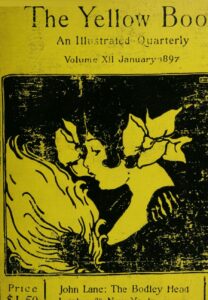
The Fin de Siècle Fairy-Tale
During Britain at the Fin de siècle, fantasy was a genre that began to appropriate the concepts of the child and childhood, specifically White middle and upper-class children. Fantasy was implemented in childhood texts to reproduce the dominant normative modes best suited for the state towards children, which were encompassed with values that were largely patriarchal and misogynistic in nature. More specifically, within the late 19th century, children’s literature was made to represent, shape, capitalize and over all control their bodies through fantasy elements. These fantasy tales began to reproduce recognizable icons, spaces and tropes that were fixed in their interactions with gender. In the late 19th century during a time of social movements and upheaval, such tropes and tales began to become problematised as stereotypes that threatened the individuality and identity of children. Fantasy was not as intangibly distant and imaginative as it seemed.
Author Evelyn Sharp’s sought to further complicate these perceptions of hetero-normative gender roles naturalized by thematic and fictional elements in fairy tales by destabilizing the predetermined narratives of popular characters through techniques of satire, presenting a kind of metafiction that challenges conventions of fiction. In particular, the short story “The Restless River” and it’s multi dimensional, ambiguous characters and their interactions with their surroundings and space highlights the relevance of spatial context, or the dominant notions that govern certain spaces to regulate gender behaviour and obedience. By investigating social constructions of space, Sharp’s text will be examined as an example of some of the ways she re-imagines alternate possibilities of the fairy tale.
Governmentality in Children’s Literature
As expressed in Huxley’s article, according to Foucault, structures of power run on a notion of governmentality — to produce knowledge that discipline the masses, including the self, through hidden discourses of power masked by technologies (p. 772). To analyze how values, cultures, and norms circulate among society, it’s environment and the conditions they are run under must be examined (Huxley, 773). This pertained to urban spaces in Britain in overtly powerful places such as government institutions or the education system that reproduced the ‘truths’ serving the government. Such truths, or ‘rationales’ were strategically placed in mediums of literature for children. By re configuring popularized fictional spaces, Sharp unveils how truths are established within them.
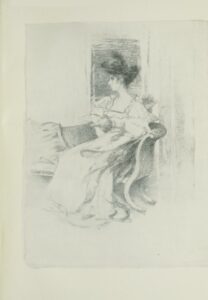
Evelyn Sharp and The Yellow Book
Evelyn Sharp, an upcoming children’s writer, socialist activist, and suffragist critiqued popular modes of childhood through the Yellow Book, a controversial periodical that garnered a reputation of decadence in it’s exploration with unconventional elements of writing and art. Evelyn Sharp was among many others to contribute to the Yellow Book, and was published twice in the twelfth volume with her short stories “In Dull Brown” and “The Restless River”, both of which displayed radically ambiguous protagonists that triumphed over gender expectations of performance. In this volume, she was also illustrated in the cover of the twelfth volume by close friend and acquaintance Mabel Dearmer, and published alongside other female and feminist writers, like Ella D’arcy. This strategic placement of women’s presence in the twelfth volume of the Yellow Book, in accordance with it’s decadent theme, suggests that Lane wanted to promote feminism as a contribution towards aestheticism, to normalize and appreciate the arts regardless of the gender behind the artist.
During this time, Sharp began to become invested in political activism, and joined movements, such as the socialist Fabian Society, the New Woman movement, and the Women’s Suffrage League (Kooistra & Denisoff). By combining her affiliations with socialism and women’s rights, Sharp forged her children’s stories with characters that performed gender in opposing ways from that of the norm, that hoped to evoke reformations of conservative constructions of childhood. In expressing her criticisms in the Yellow Book, she came to become acquainted with famous author Oscar Wilde, who’s infamous trial for “gross indecency” influenced her storytelling onward, claiming that such an event only promoted toxic connotations of masculinity and sexuality (Kooistra & Denisoff). From that point, Sharp incorporated male characters with ambiguous, effeminate features that reclaimed their femininity in her stories and recognizes the dynamic nature of gender.
“Childhood, at its worst, is unhappy; at best, it is uncomfortable” (Evelyn Sharp, Fairy Tales 1).”
“Growing up” in Victorian Britain
Being raised in a conservative girl’s boarding school, it is prevalent to see how Sharp’s own upbringing shaped her perceptions around spaces that governed gender, children, and class. During this time, girls were socialized to avoid indulgence of self interests as this would be deemed “selfish” since their primary roles were to “serve others, and always consider the interests of their menfolk first” (Moruzi, 687). White middle to upper-class girls were especially targeted to fulfill these roles, since the pervasive notion of domesticity only centred around women, and thus higher education and involvement with politics threatened their familial roles and duties as mothers at home (Moruzi, 687). Thus, girls’ education was sub standard in comparison to boys, learning the basics of literacy and domestic virtues, like cooking, cleaning, and nurturing, to fulfill the role of an atypical “noble woman” of Britain (Moruzi, 697). Enforcement of a singular, binary system delegated all children into a ‘one size fits all’ path towards adulthood, in persuasive modes of teaching that naturalized such knowledge.
Against this thought of the image of the ‘perfect’ Britain woman, Sharp further expresses in her writing her discomforts with her childhood, which was highly restricting in all areas of education and play due to her gender (Kooistra). While reflecting on her past, Sharp continued to contribute to critique the oppressive structures of Britain under the guise of children’s fairy tales. Unlike traditional tales that sought to romanticise the child and their experiences by providing unrealistic ‘happily ever after’ tales in which they are rewarded for conforming to societal expectations, Sharp attempted to do the opposite to provoke readers with the realism of childhood: that it was oppressive, confining, and did little to allow freedom for children as fairy tales falsely proposed.
Ambiguity in The Restless River
The Restless River as a metafiction brings awareness to the traditional narrative structures of the fairy tale by utilizing themes of opposition and role reversal. The story opens with the Queen of Nonamia Land, who, obsessed with being ‘original’ or non-conforming, lives life and rules the land as she saw fit. Queen Nonamia, like most humans, is complex and does not fill any singular mould. Rather, she exudes both feminine and masculine traits and performs
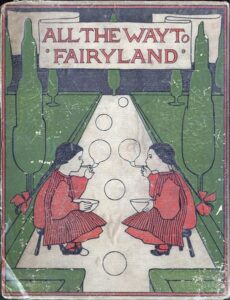
them with pride. In place of the King that commonly runs the kingdom, the Queen’s order is absolute, and she desires to rule in a fashion that prevents her from being confined by normalcy, with “nothing to help her in life but her wits” (Sharp, 167). To do this, she confesses that she marries not out of love or interest, but only so she can remain uncontrolled. She further denies marrying the youngest son, or most masculine man who proved himself through “killing a few giants”, as such men were “greatly overrated” (Sharp, 168). Focusing on the Queen’s characteristics that are more realistic and imperfect, Sharp creates room for empathy towards the Queen’s behaviour that would otherwise be depicted as threatening or deviating in mainstream perspectives.
Opposite from the Queen, the King is submissive, quiet, simplistic yet content in his role. Citizens in the land are even said to not know “anything about him, except that he was the husband of the Queen of Nonamia” (Sharp, 167). He is not a very present or vocal character within the text, but is very supportive of his wife and his son. Similarly, The Queen chooses a fairy godfather to help raise her son without “managing” her, that is, seek to control her as fairy godmothers would (Sharp, 168). The godfather represents this role well — he only hopes for the Prince to live life as he sees fit. His ‘gifts’ would only be the wisdom he can bestow upon him when the time for his adulthood comes.
After the prince’s Christening, the Queen is distraught to hear the premonition that her son will lead an ordinary life, marrying a lower-class woodcutter’s daughter from the river. To prevent this from happening, the Queen blocks the Prince from any potential areas that would allow him to desire life outside the castle, and even prevents him from becoming educated. Throughout his childhood and youth, the Prince only knows the castle walls, and in his ignorance is satisfied for the time being. It isn’t until he comes into conflict about marriage with his mother that he begins to question her methods, and becomes curious about the river outside the castle grounds. This story sounds familiar — Sharp here is mimicking the ways of life children are forced to live in Britain. By conforming to the gender rules forcefully fixed upon them in ways that keep them oblivious, such as lack of education for girls, children are to lead lives given to them at birth, and in their ignorance, their minds are governed into believing they are placed in natural, liberal states.
However, the Prince comes to enlightenment when he finds news of his future marriage predetermined by his mother, and comes to desire an autonomous life. With the aid and support of his father and his fairy godfather, he learns of a quest he must take to find his prophesied love at the Restless River. Even the journey of his adventure is non-normative; he finds a way around his tasks to avoid violence, like killing the dragon that guarded the river, and discovers that he was never ordered to kill in any way; it was his assumption that violence was the only method due to the ideals of masculinity he grew up with. In refusing these standards, the Prince breaks the enchantment, and the dragon and the river becomes their human selves once again: as a woodcutter and his daughter. From evidence of his trials, the Queen comes to accept the Prince’s love for the woodcutter’s daughter, and allows him to live life freely and simply in a smaller, lower-class house by the river. There is no grandiose, magical happy ending, however this alternate pathway lead by these characters present a hope for new imaginings in literature that celebrates ambiguity or mediocrity all the same.
Popular Structures in the Fairy Tale:
Huxley asserts that it is only under appropriate surroundings that “healthy” compliant bodies and minds can be maintained, however with territorial boundaries that barred “abnormal” bodies, that is, those that threatened to cause social disorder within them (p.774). To prevent disorderliness and chaos, structures were implemented with technologies of surveillance that problematize undesirable behaviour to keep people conscious of their actions (Huxley, p. 780). Sharp’s use of irony in depicting divergence in the way her characters navigate iconic fantasy spaces reveals how structural surveillance maintains social inequality within Victorian Britain.
The Castle
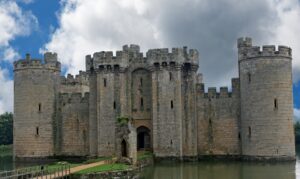
Overwhelming in size, the royal castle in fairy tales, and historically, have been depicted as symbols of political, military, and economic power and depict this in the way that they occupy large amounts of space (Martin, p.37). In literature, castle’s have always been symbolic of masculine power in which the male characters start and end their quest; the characters that inhabit them or rewarded by them, usually powerful knights or kings, redefine the castle’s meaning (Martin, 38). However, as mentioned, the Queen in Sharp’s story dominates the castle. She is portrayed as capable of leadership, becoming a ruler based on her own merit than inheritance. Here, the castle is re-visioned as a place that embraces powerful leading female figures.
The Church

Throughout history, the Church has been another symbolic structure of power and control masked by religion to run states and compliance among the masses. Royal Christenings conducted within them usually represent a joyful celebration of birth and connection with God, but Queen Nonamia’s passivity is marked inappropriate by the citizens, but she has no interest in tradition. Here, the Queen omits a traditional ceremony and appoints a Godfather for her son who further denies the performance of a typical grande Christening. Instead of a place of celebratory tradition, the Church in Sharp’s text is subverted to an ordinary building.
The Garden
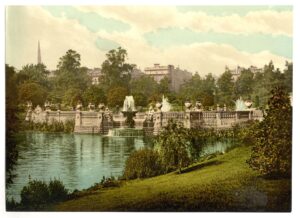
The garden has been a popular trope in children’s fantasy as what Foucault calls a hidden ‘heterotopia’ where children regain agency (Dinter, p.219). The palace garden in Sharp’s text however becomes a paradox that both oppresses but is enjoyed by the Prince. In his ignorance, the Prince finds solace within the garden, and likes to bask among it’s flowers despite his court guards ridiculing his lack of masculinity. Instead of practicing swordsmanship and violence as a Prince usually does, here the garden is a space where he can freely embrace his gentle demeanor, traits often associated with femininity. However, it’s high walls and flowers made to distract him from desiring the world outside. Under order of the Queen, he is under constant surveillance and control. Similarily, children are socialized to unquestion authority; they are rewarded for complying with the rules even under places that appear autonomous.
Conclusion
This change of common narrative is substantial to Sharp’s critique against British patriarchy. Even without living a life commonly predetermined by gender rules, each character manages to transcend the socio-cultural norms and spaces meant to define them and still finds peace within themselves and others in their ambiguity. By disrupting the elements and genre of the common fairy tale, in accordance with her involvements in socialism, Sharp re-tells the common fairy tale with characters that maintain their individuality throughout expands the genre’s potential for inclusivity. Here, she depicts the possibility of a ‘happily-ever-after’ story for people of all kinds, and a space where children are free agents of their own identities.
Works Cited
Dillenburg, Elizabeth. “Girl Empire Builders: Girls’ Domestic and Cultural Labor and Constructions of Girlhood.” Journal of the History of Childhood and Youth, vol. 12, no. 3, 2019, pp. 393-412.
Dinter, Sandra. “Spatial Inscriptions of Childhood: Transformations of the Victorian Garden in The Secret Garden, Tom’s Midnight Garden, and The Poison Garden.” Children’s Literature Association Quarterly, vol. 40 no. 3, 2015, p. 217-237. Project MUSE, doi:10.1353/chq.2015.0030.
Hollander, Amanda. “Evelyn Sharp (1869-1955),” Y90s Biographies. Yellow Nineties 2.0, edited by Lorraine Janzen Kooistra, Ryerson University Centre for Digital Humanities, 2019, https://1890s.ca/sharp_e_bio/.
Huxley, Margo. “Spatial Rationalities: Order, Environment, Evolution and Government.” Social & Cultural Geography, vol. 7, no. 5, 2006, pp. 771-787.
Kooistra, Lorraine Janzen and Dennis Denisoff. “The Yellow Book: Introduction to Volume 12 (January 1897)” The Yellow Book Digital Edition, edited by Dennis Denisoff and Lorraine Janzen Kooistra, 2014. Yellow Ninties 2.0, General Editor Lorraine Janzen Kooistra, Ryerson University Centre for Digital Humanities, 2019. http://1890s.ca/YB_V12_introduction
Levy, Michael, and Farah Mendlesohn. Children’s Fantasy Literature: An Introduction.
Cambridge University Press, 2016. doi:10.1017/CBO9781139087421.
Martin, Molly. “Castles and the Architecture of Gender in Malory’s ‘the Knight of the Cart’.” Arthuriana (Dallas, Tex.), vol. 22, no. 2, 2012, pp. 37-51.
Moruzi, Kristine. “Higher Education and Home Duties: The Morality of Self-Interest in
the Periodical Press, 1880–1910.” Victorian Periodicals Review, vol. 50 no. 4, 2017, p.
686-702. Project MUSE, doi:10.1353/vpr.2017.0050.
Sharp, Evelyn. “Fairy Tales: As They Are, as They Were, and as They Should Be”. D. B. Friend, 1889.
Sharp, Evelyn. “The Restless River.” The Yellow Book, edited by Henry Harland and John Lane,
vol. 12, London: E. Mathews & J. Lane,1897, pp. 167 — 187. Internet Archive,
https://archive.org/details/yellowjan189712uoft/page/n181/mode/2up.
